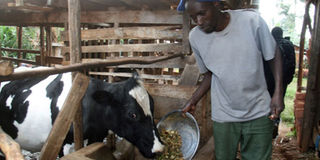Two acres, seven farms, big harvest and earnings

Kenneth Kemei of Sonokwek village in Bomet County feeds a cow on his farm. PHOTO / GEORGE SAYAGIE / NATION
What you need to know:
- Farmer will register his dairy cows with Kenya Stud Book for easy tracing of ancestry
- Biogas digester that supplies cooking gas for his kitchen and rich manure for his farm
Owning about three acres, Kenneth Kemei of Sonokwek village in Bomet County had an option of growing tea only, the main cash crop in the region.
But Kemei knows the danger of putting all eggs in one basket. He has diversified into other crops, ensuring that tea covers only a portion of the land.
His quest to grow other crops besides tea has made him an example of how to organise a farm and reap from diversity.
His 2.75 acres farm is divided into several parts, with one section hosting tea, others a zero grazing unit, fodder, bananas, sweet potatoes and bees.
“Tea occupies an acre-and-a-half. It is the main cash crop this side. I cannot abandon it because it gives me good money.”
The farmer says he gets over Sh400,000 in bonuses annually, besides the monthly pay.
The zero-grazing unit and his home cover a quarter of an acre.
FRIESIAN COWS
Kemei keeps five Friesian cows, two of which are currently lactating. He gets over 30 litres of milk every day, much of which he supplies to a local secondary school, earning Sh900 a day.
He has about half an acre of Rhodes grass, which he harvests three times annually and sells. He also grows the Kakamega3 napier grass variety, which also covers a portion of the land.
On the edges of his farm, he has planted either napier grass or Calliandra, a fodder that is a source of protein. He has also planted Sesbania sesban, another fodder that is high in protein.
Kemei further grows indigenous trees on part of his land that borders a river. He normally harvests the trees for timber and sells them.
The farmer also has 15 hives, from which he is expecting to harvest more than 100kg in about a month.
Besides the wild bees, he has started domesticating indigenous stingless bees that normally live in holes, but which he now keeps in small hives. He hopes to commercialise the project soon.
BIOGAS DIGESTER
The farmer has a biogas digester that supplies cooking gas for his kitchen and rich manure for his farm. Except for tea, all other crops on the farm depend on the cow-dung manure.
And Kemei has taken advantage of the surroundings. There are several streams and rivers criss-crossing the area as the region borders the Mau Forest.
Kemei taps water from the stream for use on his farm and home. He dag a well which stores about 40,000 litres of water.
The trained metal worker has set the tanks in such a way that water flows by gravity to his house, the zero grazing unit and to crops.
“From this well, I have enough water for my family, my zero grazing unit and even for neighbours.”
During a recent dry spell, he was supplying water to a nearby school at a fee. Ironically, the school has more roofs than Kemei.
Bomet Central Livestock Extension Officer Joseph Cheruiyot says Kemei’s farm has been identified by the Ministry of Agriculture for demonstration.
Ministry officials regularly visit the farm with farmers to teach them how to improve milk production, grow fodder, keep bees, manage the environment and conserve water.
ZERO GRAZING
“The farmer initially was keeping his cows using the free-range mode, but he turned to zero grazing and he has more than doubled his milk production, which is something farmers can learn.”
Kemei’s animals, according to Cheruiyot, will be registered in the Kenya Stud Book through Kenya Livestock Breeders Organisation to enable him become a proper breeder once he attains the pedigree status.
“Registering dairy cows in the Kenya Stud Book adds value to one’s animals. It raises the price of the animal because its ancestry can be traced thus making it easy to predict its production,” the farmer says.
The extension officer says that he has taken farmers’ groups from various parts of the country to Kemei’s farm, which is a model for proper utilisation of land.
Bomet County Water Officer in charge of Planning Victor Bosuben advises small-scale farmers to use dam liner polythene while making their underground water tanks to reduce seepage.
He notes that constant supply of water enables a farmer manage their farms well and thus reap from agri-business.



